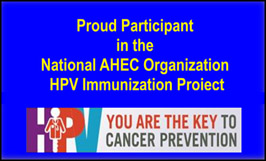You are the Key to HPV Cancer Prevention. Human papilomavirus.
Human papillomavirus (pap-ah-LO-mah-VYE-rus) (HPV) is the most common sexually transmitted virus in the United States. Almost every sexually active person will acquire HPV at some point in their lives.
HPV is short for human papillomavirus and is a group of more than 150 related viruses. Each HPV virus in this large group is given a number which is called its HPV type. HPV is named for the warts (papillomas) some HPV types can cause. Some other HPV types can lead to cancer, especially cervical cancer. There are more than 40 HPV types that can infect the genital areas of males and females. But there are vaccines that can prevent infection with the most common types of HPV.
The National AHEC Organization National Training Center embarked on improving HPV immunization rates on a national scale utilizing the National AHEC Network from 2014 – 2021. The project worked in partnership with the Centers for Disease Control and Prevention to improve the HPV immunization rates of 11- and 12-year-old males and females throughout the nation by improving clinician training and understanding of the vaccine.
To complete this project, 10 regional HPV project coordinators were hired to work closely with selected AHEC entities to establish and maintain links with appropriate resources. Corryn Gabbert, former Program Specialist with Southeast South Dakota AHEC, was the Region H Coordinator. States in Region H were Colorado, Montana, North Dakota, South Dakota, Utah and Wyoming.
For more information about HPV, visit these links at the CDC:
CDC HPV Resources
HPV Vaccine Resources for Healthcare Professionals
Frequently asked questions about HPV vaccine safety
Tips and Time-savers for Talking with Parents About HPV Vaccine
Recommended Immunization Schedules for Persons Aged 0 Through 18 Years

